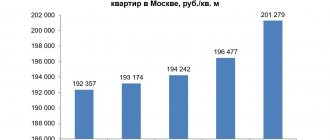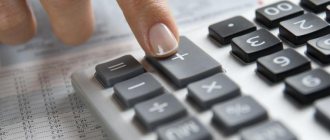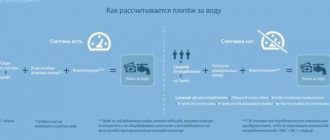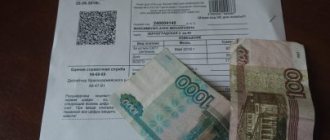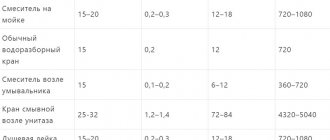Weaning technology
From management companies and homeowners associations, utility monopolists withdraw for their benefit a significant portion of the funds intended for the maintenance and repair of common property in a residential building. How?
The management company or homeowners association are, by law and under the energy supply agreement, the provider of utility services. This means that within a certain period of time, the partnership or management company is obliged to transfer to the monopolists’ account the amount for the entire house in full, regardless of how many residents have paid on that date. Suppose the debt is 10%, and then the management company, to pay the bill, is forced to take the missing amount from the money that residents paid directly to it for maintenance and repairs. And the company simply won’t have enough money to complete the required amount of work in the house. And so from month to month...
The mechanism for taking money using court decisions has been worked out perfectly by utility monopolists. Arbitration courts produce such decisions as if on an assembly line. And everything is according to the law. The only strange thing is that legislators do not see this as a problem, do not amend the laws, but enthusiastically make proposals that increase the imbalance of rights in favor of utility monopolists.
The good goal of reducing consumer costs for utility bills with the help of metering devices is now completely devalued by legislative practice, “tailored” to prevent a decrease in the income of utility monopolies and at the same time increase the costs of citizens when paying for services.
Proof of this is the annual increase in tariffs on products and products disproportionate to inflation. The state increases tariffs to please utilities and other monopolists not by the amount of inflation (8–10%), but by at least 15–20%.
How to find out the housing and communal services debt for the year? Checking your debts by payer code
If payment of housing and communal services is overdue for more than one month, in accordance with Article 155 of the Housing Code, penalties will be charged on the amount of the debt . Moreover, as the number of months of non-payment increases, the percentage of the fine will also increase:
Ways to check debts for housing and communal services
- A personal visit to the Criminal Code or the Dispatch Office is the most common and reliable way.
- When you contact the MFC, you can issue debt receipts.
- You can find out the total amount of debt at an ATM or terminal.
- Using Internet banking. Many large banks offer payment for housing and communal services on their official websites. In the same section you can find out the debt for housing and communal services.
- Using Internet services and electronic payment systems.
We recommend reading: Inserts in the Work Book How to Issue at a Budgetary Institution In 2020
Through Moscow banks, you can check the debt to housing and communal services at the place where payments for utility bills are accepted. In addition, ATMs and terminals are programmed to issue a check against a personal account with data on the amount and timing of transfer of payments for the apartment.
All telephone numbers that provide information about the status of personal accounts are indicated on paper receipts. Additionally, this data can be obtained at the reception of the management company, housing and communal services, HOA, as well as at information stands located in the house.
Checking debts for housing and communal services through Moscow banks
After selecting the region and place of residence, the page will display a list of resource supply organizations. In addition, you will need to specify the calculation method. This can be done using an identification code or from the state information system.
The collected documents should be sent by registered mail, accompanied by a notification and a list of enclosed documents. After that, wait for a response. If this action does not bring any positive results, go to court with the same package of documents.
The easiest way to find out the utility debt by name is to contact the post office, where employees will provide the necessary information. Or use payment terminals.
Non-existent rent debt accrued: what to do
- Contact your home maintenance company. This can be done over the phone or in person. To obtain up-to-date information on the amount of debt for utility services, it is enough to indicate the address of the apartment.
- In financial institutions that accept payments from clients for housing and communal services. To find out information about the debt, you can specify both the address and the personal account.
- Using the services of Internet portals, having previously completed the mandatory registration procedure. Using official websites, you can receive information about accounts and debts at any time of the day. But do not forget about Internet security so that your personal data does not fall into the hands of scammers. To do this, you should use only official portals, such as the government services website.
At the cash desk of any bank it is possible to get an answer to your pressing question in the area of paying for utilities. Of course, you can traditionally go to the nearest housing and communal services department, which already stores the payer’s personal account. Some representatives of the older generation are accustomed to finding out the amounts for utilities at the post office. Today, you can use this method quite freely, risking spending a significant part of your time at the end of the month waiting for your turn.
And the counter doesn't help
Our utility costs, despite the use of metering devices, are growing, and the costs of maintaining a residential building and its repair are decreasing. Most management organizations apply prices set by the city government for the population. This is the main condition for the allocation of budget subsidies. It is for this reason that few people have the desire to set the price higher, although according to the Housing Code it can be individual for each house, depending on its technical condition and the whims of the residents.
The city rate of planned and normative expenses for the maintenance and repair of common property remained at the 2010 level, and the tariffs of utility monopolies increased by an average of 15%. This means that in 2011 Muscovites must pay tribute to utility monopolies 30% more than in 2010. Thus, the situation with underfunding of housing maintenance has worsened.
Tariffs are set for the utility company as a supplier of last resort by the regional energy commission and the Moscow government. For the population, it is the same, regardless of how the house is managed and includes the average costs of a utility company for the acquisition of resources, production, transmission of energy and energy carriers and the provision of public services, including costs associated with the production and provision of public services. The tariff includes the rate of return (or planned profitability of production) of the energy supply company.
For example, the heat produced by MOEK OJSC is 30% more expensive at cost than the heat produced by MOSENERGO OJSC. But in the sales structure of MOEK, 65% is cheap heat purchased from MOSENERGO and no more than 35% is expensive, our own. As a result, the tariff for the population turns out to be 7–8% lower than the tariff for other heat consumers.
Thus, it is quite correct to say that the population purchases utilities at a minimum at cost and, at a maximum, much more expensive. And talking about charity towards residents on the part of this organization is, to say the least, frivolous.
The nuances of rent through the Bank of Moscow
- The period when the debt was accrued and the region where the residential premises were built;
- The exact address of the apartment or country house;
- Number of floors of the building;
- Type of improvement of the apartment and its area;
- Category of ownership and type of tenancy;
- The number of registered persons who live in the residential area.
Remote service
To pay for utility services, it is not necessary to stand in line at payment collection points. Clients of VTB Bank of Moscow can make utility payments online at any convenient time
.
To do this, just connect to Internet banking or mobile banking
. New details of the Bank of Moscow after the reorganization.
Thus, if a citizen has a debt for housing and communal services, it is advisable to pay it off as soon as possible, otherwise penalties may be charged. You can check the debt for housing and communal services in Moscow on the official website of VTB (absorbed Bank of Moscow in 2020).
- SD – current amount of debt.
- SR – refinancing rate. Determined by the Central Bank. Currently it is 7.25% per annum.
- SDZ – debt validity period. In this case, it is also necessary to take into account the day when the debt will be repaid. It is also taken into account.
How to check rent debt online: by address and last name
If you have incurred debt for a year, it is better to find out about the amount of debt by visiting the management company or settlement center (MFC). In these organizations it will be possible to print out a debt receipt. It will be quite difficult to repay the annual amount of debt in one payment. Therefore, the MFC develops a repayment schedule with the generation of several receipts for payment.
- Is it possible to get rid of them and when will the debt be written off, how can I get help with restructuring?
- Why do you need a certificate of no debt on utility bills and how to get it?
- How to file an application to cancel a court order for utility bills, what is the statute of limitations and how to write an application to live without debt?
- Penalties for late utility payments.
- Are the debts transferred to the new owner?
We recommend reading: Is a Working Military Pensioner or Military Veteran Entitled to Additional Unpaid Leave?
If it is impossible to use the State Services website for one reason or another, you should use the websites of the management or resource supply company. Most often, they implement a similar service, but in some cases it may take some time to process the request.
How to determine the payment amount offline?
There are two fundamentally different options for contacting specialized authorities. This can be done either via the Internet, on the websites of authorized organizations, or without using it, using a telephone, a bank terminal or a personal visit to a settlement center.
These are large online portals that provide comprehensive information about the procedure for providing state and municipal services, and also, among other things, provide the opportunity to find out and pay debts via the Internet.
See the benefit
Don’t you find it strange that all conversations and discussions in the housing sector come down to what is better: an HOA or a commercial management company? Who should manage: professionals or cooks?
Of course, they are professionals, theorists and deputies, engaged by business and utility monopolies, convince us. And so, word by word, HOAs are already moving into the background.
Meanwhile, the third method of management – direct – is being implemented quite successfully in Russian cities. And I don’t remember any information about scandals, high-profile criminal cases related to the fleecing of residents in these cities.
So, what benefits does the direct method provide when paying for utilities?
Owners and tenants in “direct” houses, as consumers, enter into contracts for the provision of utility services directly with utility companies or with agents authorized by them (intermediaries who assume the status of providers of utility services). In both the first and second cases, the subscribers of the utility company are residents. This is a very important circumstance.
No matter how many intermediaries there are between the consumer and the utility, you are a subscriber of the utility, not a subscriber of the intermediary. There are no additional fees, because the tariff for the population takes into account all expenses and all losses of the utility company, including losses on the way to the apartment and the agent’s fee for mediation. The risk of non-payment by consumers is borne by the utility company. You are not responsible for your neighbors' non-payments. Everyone pays only for themselves.
To work with direct consumers - subscribers of a utility company, the service provider, represented by the company itself or its agent, is required by law to enter into an agreement with each subscriber and use meter readings for mutual settlements.
Accounting and distribution of general household expenses with the direct management method are the subject of an agreement concluded by each individual subscriber with the utility company. Let's consider the schemes that can be used in calculations.
For example, a house has a common metering device (BMU), while individual metering devices (IMU) are available in some apartments. A consumer who has an IPU pays for utilities in two parts: according to the readings of his meter and the share of expenses for general needs for appliances installed in public areas. It can be determined by the proportion of the total area of the consumer's apartment in relation to the total area of the house.
Residents of apartments that are not equipped with an IPU pay for services according to the general meter data minus the amount of apartment readings. The share of expenses can be determined by the number of registered or actual residents living in the apartment. The second part of the payment for general household expenses is determined in the same way as for those with private pension funds. Consumers do not bear any additional costs.
House-wide networks, through which services are provided, are leased to a utility company. Funds from rent, by decision of the general meeting of premises owners, are allocated for the maintenance of common property, its repair and other purposes.
How to find out the debt for payment of housing and communal services
The easiest way to clarify the debt is to use the management company’s website. The user needs to log in and create his own personal account, which will help monitor accruals twenty-four hours a day. Penalties in case of late payment will also be displayed here. When registering, the apartment address and account number are indicated. Based on the recorded data, the system will be able to identify all charges for a specific area of housing and communal services.
We recommend reading: Check of Rospotrebnadzor Table of Medical Books
Find out how to pay housing and communal services via the Internet
Using the calculator, exact numbers are determined based on the calculation method and tariff rate. In the personal account, the user clearly monitors all changes, and also independently records the readings of all accounting equipment from the apartment.
How to find out debts for housing and communal services? There are a large number of ways to look at housing and communal services debt. You can do this remotely, without leaving your home, or you can go to organizations that have such information.
